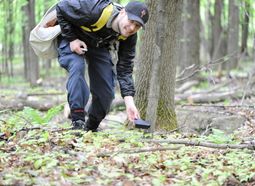To fight Lyme disease, you need more than one line of attack. At Université de Montréal's Faculty of Veterinary Medicine, researchers have started using tick poison on mice, which are key hosts for the bacteria responsible for the illness.
"The ticks climb onto mice, bite them and contract the bacteria," explained veterinary epidemiologist Jérôme Pelletier. "That's how the disease is spread. We want to break the cycle."
Throughout his master's and doctoral studies at UdeM, Pelletier worked on a field project in the Eastern Townships to disrupt the Lyme disease transmission cycle. A trial run in Farnham was followed by a larger-scale test in Bromont, one of the towns at greatest risk for Lyme disease.
"Jérôme's initial study in Farnham had demonstrated the effectiveness of the technique, but this was the first time an intervention of this type was attempted in a real-world setting frequented by the public," explained veterinary medicine professor Cécile Aenishaenslin.
The results of the four years of fieldwork were recently published in the journal Ticks and Tick-borne Diseases.
A comprehensive strategy
"We developed and evaluated a comprehensive prevention strategy, which included a community component to increase public awareness and improve preventive behaviours," said Aenishaenslin, who has been working since 2008 on implementing One Health-aligned interventions to prevent and control emerging zoonoses, including tick-borne diseases.
Rodent bait containing fluralaner, a pesticide used to protect dogs and cats from tick bites, was laid at numerous sites - in private yards, along public trails - in Bromont, a major partner in the study. Mice were unharmed after ingesting the bait but any ticks that bit the mice died.
The study also included untreated control sites. "We wanted to show that the number of ticks and the proportion carrying Lyme disease would be lower at the treated sites compared with the controls," said Pelletier.
Laying the bait
The bait was laid from spring to autumn in 2019, 2020, 2021 and 2022, and tick sampling was carried out in summer and autumn each year to capture all of thw ticks' life stages (larva, nymph, adult).
Although there was an unusually low tick count in 2020, the study continued. "The ticks have their ups and downs, which is one of the reasons why interventions of this type are very difficult to develop," Pelletier noted.
"We're dealing with myriad environmental factors that complicate statistical analysis."
In 2021 and 2022, the researchers found a reduction in tick density of approximately 39 per cent at the baited sites. When taking measurements in a widening radius around the bait sites, the researchers still found lower, albeit gradually increasing, tick densities.
"The further you moved away from the treated site, the greater the tick density, so the effect spreads spatially," Pelletier said.
The researchers also found a significant reduction in the proportion of infected ticks at the baited sites compared with control sites.
A need to be cautious
"We can say that the intervention works but we have to be cautious: reducing the number of infected ticks won't automatically translate into fewer human cases," Pelletier warned.
Aenishaenslin agreed: "That's the thing we still have to study," she said. "We see a good reduction in tick density, but is this enough to reduce the number of people exposed to bites and, in the long term, the number of cases? We believe the effect is probably modest."
In the fight against Lyme disease, personal protection remains the first line of defence-especially since the use of fluralaner to control ticks is only approved in pets or on an experimental basis.
Research is ongoing. For example, the PARCS en santé project is looking at the role of white-tailed deer in the equation. "In the next stages, we will try combining different interventions to maximise the effects," said Aenishaenslin.
Some strategies are more appropriate in some settings: "If you're likely to encounter a tick every time you step outside, personal protective measures can be hard to maintain," Pelletier observed. "That's where environmental measures like this one could prove useful."
About this study
"Rodent-targeted fluralaner baiting reduces the density of Borrelia burgdorferi-infected questing Ixodes scapularis ticks in a peri-urban setting in southern Canada," by Jérôme Pelletier, Cécile Aenishaenslin et al., was published in the March 2025 issue of Ticks and Tick-borne Diseases.








